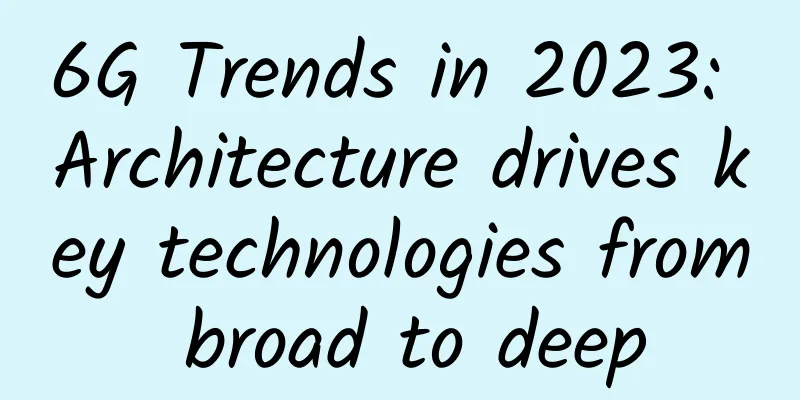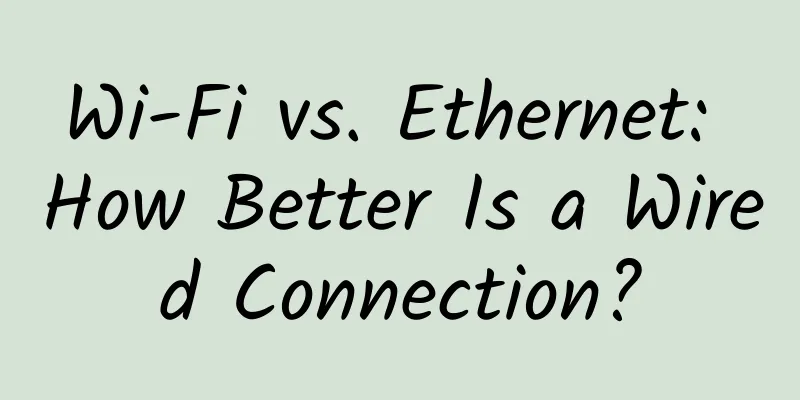6G Trends in 2023: Architecture drives key technologies from broad to deep

|
With the large-scale commercial use of 5G networks, the research and development of 6G networks has also been put on the agenda and has gradually become a hot topic of research in industry, academia and research. Major economies around the world have launched 6G network research and development, and promoted the development of 6G network innovative technologies through the deployment of scientific research projects. 6G networks have become the commanding heights of a new round of scientific and technological innovation and industrial transformation. At present, the development of global 6G networks is still in its early stages, and the industry is still exploring the development direction and technical path of 6G networks. In the development process of 6G network technology, network architecture is crucial. It will define the development form of the network, determine the direction of technology and affect the industrial foundation. It is global, systematic, inherited and forward-looking. In the past year, through the research on 6G network architecture, several candidate network support technologies have been preliminarily selected and some technical explorations have been carried out. In 2023, the research on 6G network architecture will still be a top priority, and on this basis, the research on various key technologies will be gradually focused and deepened. Trend 1: 6G network architecture will move from outline design to detailed designThe mobile communication network is a complex system, and the network architecture is the foundation of this complex system, which determines the efficiency and capacity of the entire system. The development of the network architecture is one of the core signs of the intergenerational development of the mobile communication network, and is the "skeleton" and "hub" of each generation of communication network. In September 2021, the IMT-2030 (6G) Promotion Group released the "6G Network Architecture Vision and Key Technology Outlook White Paper" (hereinafter referred to as the White Paper), which for the first time proposed development guidance for 6G network architecture and key technology fields. The White Paper points out that network technology innovation will play a more critical role in the 6G stage, and explains the driving force of the evolution of 6G network architecture from three aspects: new business scenarios, DOICT fusion technology, and IP networking. The 6G network architecture design principles of "adhering to network compatibility and insisting on simple design" and "transforming from centralized to distributed, from incremental to integrated, from external to endogenous, and from ground to ubiquitous" were proposed. The White Paper expounds on the vision of a distributed and autonomous 6G network architecture, and introduces the twelve potential key technologies of 6G networks, laying the foundation for promoting consensus among industry, academia, and research on key technologies of 6G networks. In June 2022, China Mobile proposed the overall architecture design of 6G network with "three bodies, four layers and five sides" through systematic analysis of driving forces, research and judgment, and concepts, presenting a cross-domain, cross-layer, multi-dimensional and three-dimensional 6G network architecture from three perspectives: spatial view, layered view and functional view. Among them, the "three bodies" are the network body, management and arrangement body, and digital twin body, the "four layers" are the resource and computing power layer, routing and connection layer, service-oriented function layer, and open enabling layer, and the "five sides" are the control plane, user plane, data plane, intelligence plane, and security plane. The overall architecture of "three bodies, four layers and five sides" is the industry's first systematic 6G network architecture design, which will effectively promote the industry to form a consensus on 6G architecture design and key technology selection. On the basis of the overall architecture design, China Mobile further provides the twin design, system design and networking design of the architecture implementation. Through digital means, a virtual twin is created to realize a digital twin network architecture (DTN) with network closed-loop control and full life cycle management. Through service-defined end-to-end systems, a full service system architecture (HSBA) is realized. On the network, a distributed autonomous network (DAN) with distributed, autonomous, self-contained features is realized, which supports on-demand customization, plug-and-play, and flexible deployment. In 2023, 6G network architecture research will remain a top priority. The logical architecture of the 6G network has taken shape, but the local architecture needs to be further improved and refined, and gradually move from outline design to detailed design. Trend 2: 6G network key technologies are gradually converging and moving towards in-depth researchSystem architecture plays a vital role in network design. With the industry's continuous exploration of 6G network technology, driven by network architecture, 6G network key technologies will gradually focus on 2023, and move from broad directional exploration to in-depth technical research on specific topics. This article lists eight key 6G network technologies that may be focused on, and analyzes the potential in-depth research directions of each technical point in 2023. Full service architectureSince the introduction of 5G, the service-oriented architecture has been continuously developed, from SBA to eSBA to 6G HSBA. In the 6G era, its scope will be expanded to wireless access networks, user planes, etc., to achieve thorough service-orientedness, thus laying the foundation for architecture design. The full service-oriented architecture HSBA is the core and cornerstone in the overall architecture of 6G, and is the basic design of each functional plane in the service-oriented functional layer. In the 5G network, services still need to be attached to a certain network element. This model limits the flexible upgrade and free combination of services to a certain extent. In the future network, there will be a trend of increasing network scale and increasing personalized needs of industry networks. The 6G network will gradually develop towards a combined deployment mode of "centralized + distributed". In the network structure design of 6G, whether it is possible to truly break the limitations of network elements, eliminate the coupling between different atomic services, and deeply implement the service-oriented design concept is an urgent problem to be solved. HSBA should be enhanced in terms of service framework, service interface, atomic service, etc. to adapt to the distributed organization of the network, the intelligent scheduling of services and the flexible deployment of industry-specific networks. By 2023, the full service architecture will evolve in the following three aspects: First, the service framework will evolve in a more distributed direction, optimize the decoupled design of services, and further realize the independence of communication functions by decoupling the network's business processing and general communication functions, thereby establishing a stable communication mechanism in massive services, complex architectures and networks; Second, the service interface will develop in a more flexible, open, efficient and reliable direction. In the process of 6G network evolution, it is necessary to actively absorb emerging IT protocols, and the control plane and user plane protocol design will evolve towards the next generation of Internet protocols; Third, atomic services will be further decoupled and reconstructed to support more flexible combinations and lighter calls. By further decoupling and reconstructing atomic services, it is truly possible to deploy applications without considering infrastructure construction, and realize automated construction, one-click deployment and service startup. Distributed AutonomyDistributed autonomy has become an important trend in the 6G core network. 6G will be oriented to more industries, and its business scenarios will be more diversified, dynamic, and complex. There will be more localized requirements for signaling and data processing, and it will be necessary to quickly and adaptively build networks and adjust functions and services according to the changing environment. Based on the distributed autonomous network framework, new networks can be easily and quickly built, automatically connected to the running 6G overall network, and run autonomously without human intervention and management. It can automatically sense environmental changes and make real-time network adjustments. In 2023, distributed autonomy will evolve in the following aspects. The first is the homogeneous composition and on-demand expansion of distributed network functions. The distributed network units of the 6G core network include basic functions such as the control plane, user plane, and data plane, and have basic capabilities such as user control and data forwarding, thus forming a homogeneous distributed homogeneous micro-cloud basic unit. The micro-cloud unit can be personalized and expanded according to specific business scenarios, user scale, geographical environment and other requirements, increase customized network capabilities, and quickly generate personalized networks, thereby providing targeted network services. The second is mobility management and business continuity in distributed networks. Based on distributed stored user context data, users can achieve "zero interoperability" cross-domain mobility and lossless business continuity. Based on the coordination between distributed units or between distributed units and centralized units, complex services and cross-regional roaming can be achieved. The third is the reliability management of the distributed network. When a distributed unit fails, other units can take over the users under the unit without loss through the distributed stored user context data. Fourth, the automated management of distributed networks. Through dynamic perception and cognitive learning of the network environment, intelligent generation of network architecture, system functions, and self-maintenance and self-management can be achieved. Digital Twin6G network will build parallel physical and digital networks, forming a virtual-real integration management method, which supports real-time modeling of different networks and business forms on the one hand, and flexible and real-time integrated policy control from virtual to physical entities on the other hand, and further supports the prediction and iteration of physical systems based on digital systems, so as to achieve low-cost trial and error, intelligent decision-making, and high-efficiency innovation of the network. For multi-dimensional resources such as data, storage, forwarding, and computing, through the twinning mechanism, reusable, easy to manage, lightly customized, adaptive, and predictable "physical + digital" mapping, feedback, and closed loops are achieved, and dynamic, automated deployment and optimization of overall and local multi-form resources are achieved. In 2023, the digital twin network will be studied in depth from the following two aspects. The first is how to perform partial or complete twin mirroring of the network entity. Building a network twin requires four key elements: data, model, mapping, and interaction. All network functions in the 6G network architecture can build corresponding network function twins on demand. The twins can interact with the real physical network in real time, restore the operating status and environment of the real physical network through modeling and mapping, and perform pre-verification before network deployment, thereby providing the optimal solution for network strategy and improving the reliability of network decision-making and deployment. The second is how to help 6G networks realize the intelligent side through internal and external closed loops, and achieve goals such as flexible networks and endogenous intelligence. Network operation and maintenance and optimization, network intelligent applications, intent-driven network intelligent autonomy, as well as new network technologies and new business innovations can all input requirements to the twin through the northbound interface, and deploy and verify services through the modeled instances of the network twin. The network capabilities are verified through the twin's endogenous closed loop. After verification, the twin sends control updates to the physical entity network through the southbound interface. Innate wisdom6G networks embed AI capabilities to achieve endogenous intelligence at the architecture level. Internally, they can use intelligence to optimize network performance, enhance user experience, and automate network operations, that is, AI builds networks; externally, they can extract and encapsulate network intelligence to provide communication and computing services that combine network and AI for users in all walks of life, that is, network empowers AI. Through embedded AI capabilities, DOICT-integrated intelligent perception, intelligent connection, intelligent discovery, intelligent service, intelligent management, and intelligent orchestration are realized, laying the foundation for the intelligent connection of all things. In 2023, the following key points will be considered for endogenous intelligence. The first is the transition from cloudification to distributed network intelligence. Due to the distribution characteristics of data and computing power in the network, 6G is required to build an open and integrated new network architecture to achieve the transition from traditional "Cloud AI" to "Network AI". The second is the shift to increased attention to uplink transmission performance. Unlike previous networks that focus on downlink transmission, intelligent services will bring more frequent data transmission between base stations and users. It is necessary to focus on the scenario requirements of uplink communications to more effectively support the application of distributed machine learning. The third is the transition of data processing from core to edge. In the future, data localization, extreme latency performance, and low-carbon energy saving will require computing to be brought to data, supporting "where the data is, data processing is there". In order to cope with these changes, the new network architecture needs to be able to use intelligence to optimize network performance, enhance user experience, and automate network operations internally, namely AI4Net, to achieve intelligent connection and intelligent management; at the same time, it needs to be able to provide real-time AI services and new real-time computing services to users in various industries externally, namely Net4AI. Air-space-ground integrated networkingWith the rapid development of aerospace technology, in order to meet the needs of Internet access and broadband data transmission in remote areas, sea and airspace, disaster relief and other scenarios, the use of space-ground networking to provide Internet services has attracted more and more attention. In the 6G network, space-based, air-based, and ground-based networks will be deeply integrated to form an integrated space-ground network with full coverage, providing users with ultimate, reliable, and continuous communication services. In 2023, research on the integrated space-air-ground network will be further developed around the following aspects: First, the integrated network architecture with distributed on-demand deployment. The integrated space-ground information network will provide full-scenario services, and the network should be able to provide matching network service capabilities according to different business needs. The 6G network needs to build an on-demand, flexible and efficient network capability resource pool to achieve on-demand customization, dynamic deployment and elastic scaling of network capabilities, and adapt to the reliability and robustness requirements of the integrated space-ground information network. The second is mobility/session management and dynamic routing technology. Due to the problems of satellite constellations such as rapid dynamic changes in network topology, large transmission delays, and poor robustness of inter-satellite links, the mobility management and session management of the integrated space-air-ground network are urgent issues to be solved. At the same time, large-scale dynamic routing technology and efficient network resource management strategies can help improve indicators such as bandwidth and latency, and improve user service quality. Mobile computing networkIn the 6G era, the network is no longer a simple communication network, but an information system that integrates communication, computing, and storage. It realizes endogenous computing internally and provides computing services externally, reshaping the communication network pattern. In order to meet the needs of new network services and lightweight and dynamic computing in the future, the integration of network and computing has become a new development trend. Under the general trend of deep integration of network and computing, the core requirement of network evolution is mutual perception and high coordination between network and computing. The computing network will realize ubiquitous computing interconnection and efficient coordination of cloud, network, and edge, improve the utilization efficiency of network resources and computing resources, and then realize real-time and accurate computing discovery function, flexible and dynamic scheduling function of services, computing service function, computing network orchestration management function, computing routing function, and improve the consistency of user experience. In 2023, the mobile computing power network will focus on in-depth research on computing power measurement and modeling technology, computing power routing technology based on computing power resource perception, and on-line computing technology. Deterministic NetworkingMobile communication networks are gradually transforming from serving the consumer Internet to serving the industrial Internet, and will gradually become the technical foundation of the industrial Internet, the energy Internet of Things, and the Internet of Vehicles, as well as the driving force for industrial upgrading and development. In the future, the further integration of ICT and OT will enable mobile communication networks to evolve from providing "best efforts" services to providing "deterministic" services. The 6G era is an era of widespread development of deterministic networks, which will shift from the independent development model of mobile and fixed networks to the cross-domain integrated development model. The deterministic network for 6G will be an endogenous deterministic network with cross-layer determinism and cross-domain integration. In 2023, deterministic networks will focus on how to integrate mobile networks with fixed network deterministic mechanisms, how to break through traditional IP layer forwarding mechanisms, and how to ensure accurate cross-domain time synchronization. In addition, the realization of cross-domain end-to-end deterministic networks will involve multiple network segments and multiple levels of technology. It is a combination of multiple technologies, and improvements can be attempted from the aspects of reducing complexity, dynamic adaptation, and combining specific services. Data ServicesIn the future, the 6G ecosystem itself will generate, process, and consume massive amounts of data. These data will enable more complete intelligent services and provide value-added channels for operators, but at the same time, they will also put forward new requirements for operators to organize and manage data efficiently. An independent data plane may be introduced into the 6G network architecture to build a unified and trusted data service framework at the architecture level and provide trusted data services. In 2023, data services must focus on heterogeneous and multi-source data collection, processing and massive storage on the one hand, and also need to focus on how to integrate existing data service single-point technologies, based on "decentralized" trusted mechanisms and intelligent analysis driven by data and knowledge, to realize data services and trusted services from the system architecture level. The next 3 to 5 years will enter the "window period" for 6G network developmentInnovation in network architecture is related to the overall development of the network. The emergence of new demands, new scenarios and new technologies has endowed the 6G network architecture with multi-dimensional capabilities such as computing, perception, intelligence and security in addition to traditional connection and forwarding. It has also brought new driving forces for the innovation of 6G network architecture, which will significantly enhance network capabilities and provide users with a more extreme and richer service experience. Aiming at the commercialization of 6G around 2030, the next 3 to 5 years will enter a strategic window period for the development of 6G networks. The integration and innovation of new DOI2CT elements and mobile networks will inject strong impetus into the design of the new generation of mobile network architecture, which is expected to solve the air interface bottleneck, greatly improve network performance, and promote the leapfrog development of 6G networks. Therefore, the industry needs to continue to invest in related supporting technologies such as full service architecture, distributed autonomy, digital twins, endogenous intelligence, integrated air-ground networking, mobile computing power networks, deterministic networks, and data services, and conduct in-depth research to lay a technical foundation for the development of 6G networks. |
>>: The data is not real-time enough: try long connection?
Recommend
5G Thinking and Development: 5G development is just in time
Mobile communication technology advances every te...
On the eve of 5G, mobile phone companies should not panic
Not long ago, a video about 5G experience by &quo...
Small router, do you really understand its structure?
There are four main types of routers in the netwo...
Revelation from global 5G speed test: Can operators break away from homogeneous competition?
The same coverage, the same bandwidth, the same m...
DYXnet brings AI+ cloud network security services to Beijing Animation Week 2024 to support the innovative development of the animation industry
The development of the animation industry is of g...
Scientists convert Wi-Fi signals into electricity to charge devices
Wireless charging, which we often refer to, gener...
How to configure OVN router?
Overview Based on the experimental environment in...
How 5G frequencies affect range and speed
Experts say that while 5G technology is a huge im...
V.PS Netherlands CN2 GIA/AS9929 line AMD Ryzen7950X+DDR5+NVMe high performance starting from €39.99/year
V.PS has launched two high-performance VPS hostin...
HTTP, TCP, IP, and Ethernet in one article
This article is reprinted from the WeChat public ...
HostKvm New Year Promotion: 30% off Hong Kong International/Los Angeles VPS, 20% off other data centers
HostKvm also released a promotional plan for the ...
Nexril: $9/quarter KVM-1GB/15G SSD/1TB/Dallas data center
Nexril is a site under Corex Solutions, LLC. It w...
Guanmai Technology CTO Miao Quan: Steadily enter the SD-WAN market and be prepared to deploy 5G
[51CTO.com original article] From the emergence t...
Controlling the throat of the Internet of Things, what value can wireless communication technology bring to the application field?
Communication technology has been the most talked...









